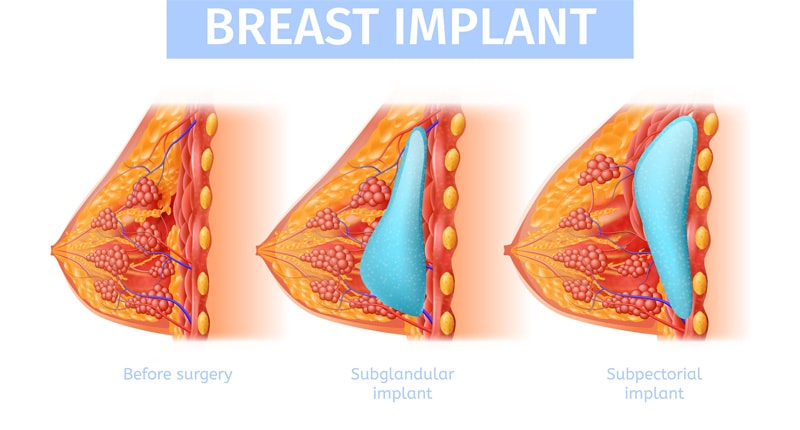IMPLANTS AND BREAST CANCER
Women have been enhancing their breast with implants, a procedure called augmentation mammoplasty, since the 1970s. Despite multi-million dollar lawsuits, there has been no scientific evidence that implants cause breast cancer. In fact, there are studies showing that women with implants have a slightly lower incidence of breast cancer compared to women who do not. Implants do not substantially impair breast cancer detection. In fact, implants push the breast tissue up and outward toward the skin, often making tumors easier to feel. Mammograms, ultrasounds (sonogram) and MRIs can be done safely on women with implants and these tests do not cause implants to rupture (see Mammogram in Women with Implants).
There are different types of implant materials, textures and shapes depending on what the woman wants to achieve. In addition, implants can be placed in front (anterior) to the pectoralis major muscle or behind it (posterior).

What happens to women with implants if they get breast cancer? First of all, implants don’t make the cancer any worse. However, implants do affect how we approach surgery because although the primary goal always is to cure the cancer, once survival is achieved, the secondary goal is to have women look the same or better than they did before they had the cancer.
In my experience, most women who have had breast augmentation are concerned about the impact of cancer treatment on their appearance. These women like their implants and don’t want to loose them. There is a second, smaller group of women who have wanted their implants replaced for years but could not afford it…until now. And then there are patients who want their implants removed and never want to see them again.
For small or early stage breast cancer (tumor < 5 cm) one option is lumpectomy (partial mastectomy) and radiation (see Breast Conservation Surgery). The problem is that women with implants usually have a small breast, that’s why they got implants in the first place, so a lumpectomy can take away 30% or more of the breast volume. Furthermore, radiation often causes the remaining breast to shrink and may lead to capsular contraction, which can make an implant feel hard and deformed. In cases like this, sometimes it’s better to remove the entire breast but leave all the skin and the nipple areolar complex and then reconstruct. We perform these types of operations regularly. The rate of cancer recurrence is around 3%. We can almost always obtain symmetry with the other side and the cosmetic outcome can be fantastic (see Gallery).
